Make this fast and easy Homemade Pizza Dough recipe with only 5 ingredients—perfect for a 13X9 sheet pan or a thinner crust 16-inch round pizza.
Have dinner on the table in under an hour. Make a small batch or for a crowd. An economical, adaptable pizza dough that can be made ahead and may be used for thick or thin-crust pizzas.
Ingredients
Flour—usually all-purpose flour
Yeast—rapid or quick yeast
Sugar
Salt
Olive oil
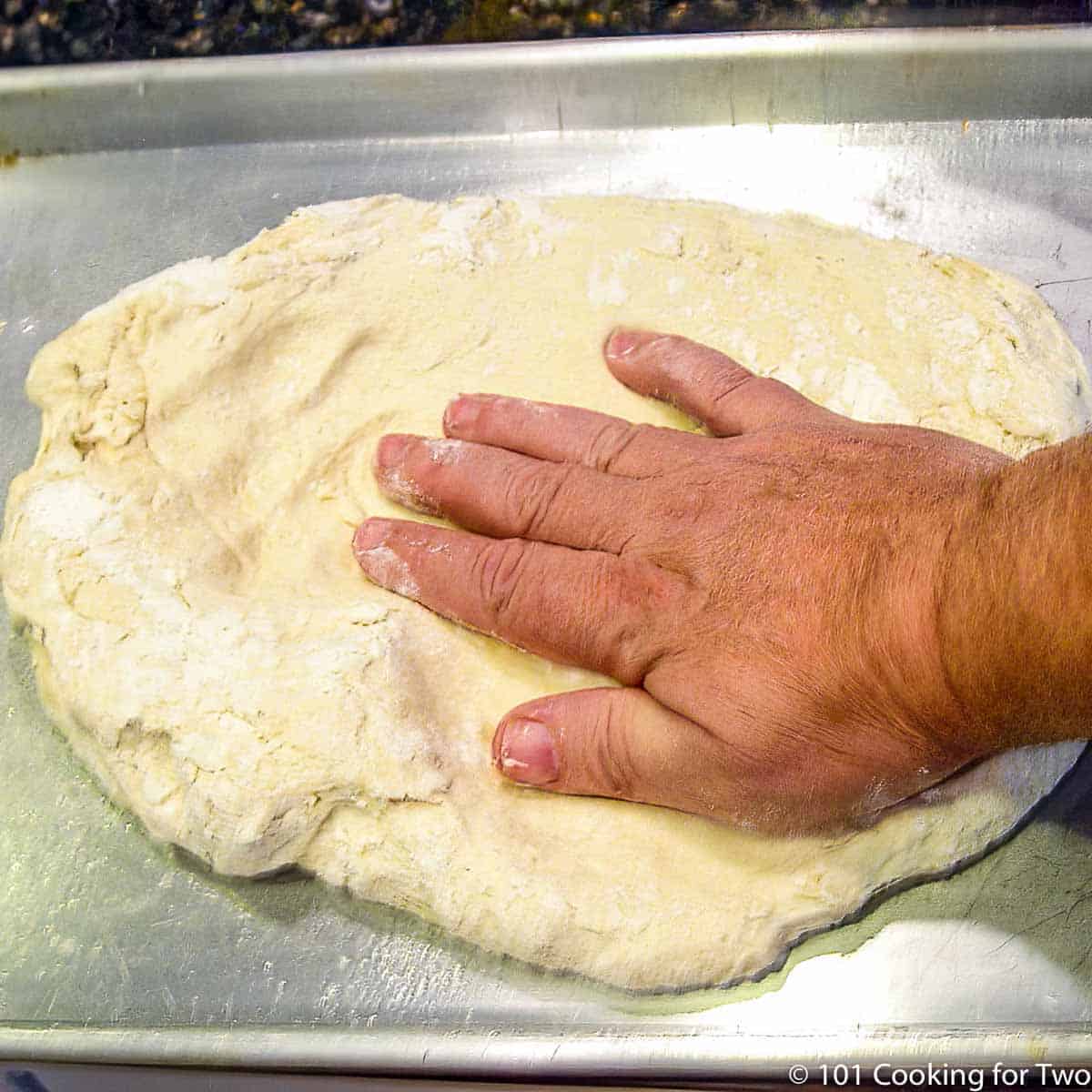
Jump To (scroll for more)

Featured comment from Kris:
"5 stars. Nice and crisp when cooked and held up to way too many toppings that my husband chopped for me. We really enjoyed. Best pizza I've ever made! Thanks so much."
I have used this easy pizza dough recipe for over 50 years. It may have evolved slightly, but the basic recipe is the same. A few simple steps are all that is needed: five ingredients and mix them by hand.
If you don't want yeast pizza dough, try No Yeast Biscuit Pizza, which uses baking powder. Other pizza choices are French Bread Pizza, Crock Pot Pizza, or Tortilla Pizza.
👨🍳How to Make Homemade Pizza Dough—Step by Step
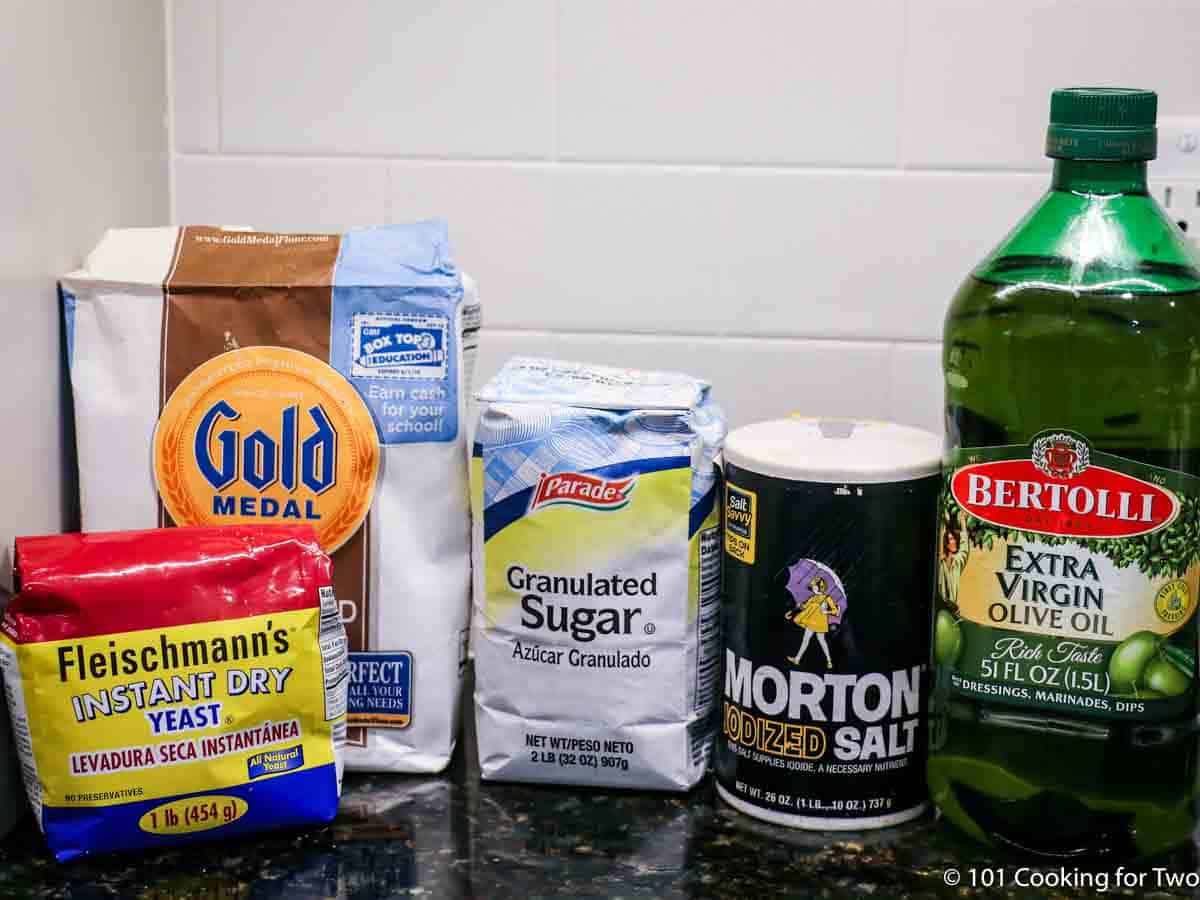
Ingredients most of us have on hand.
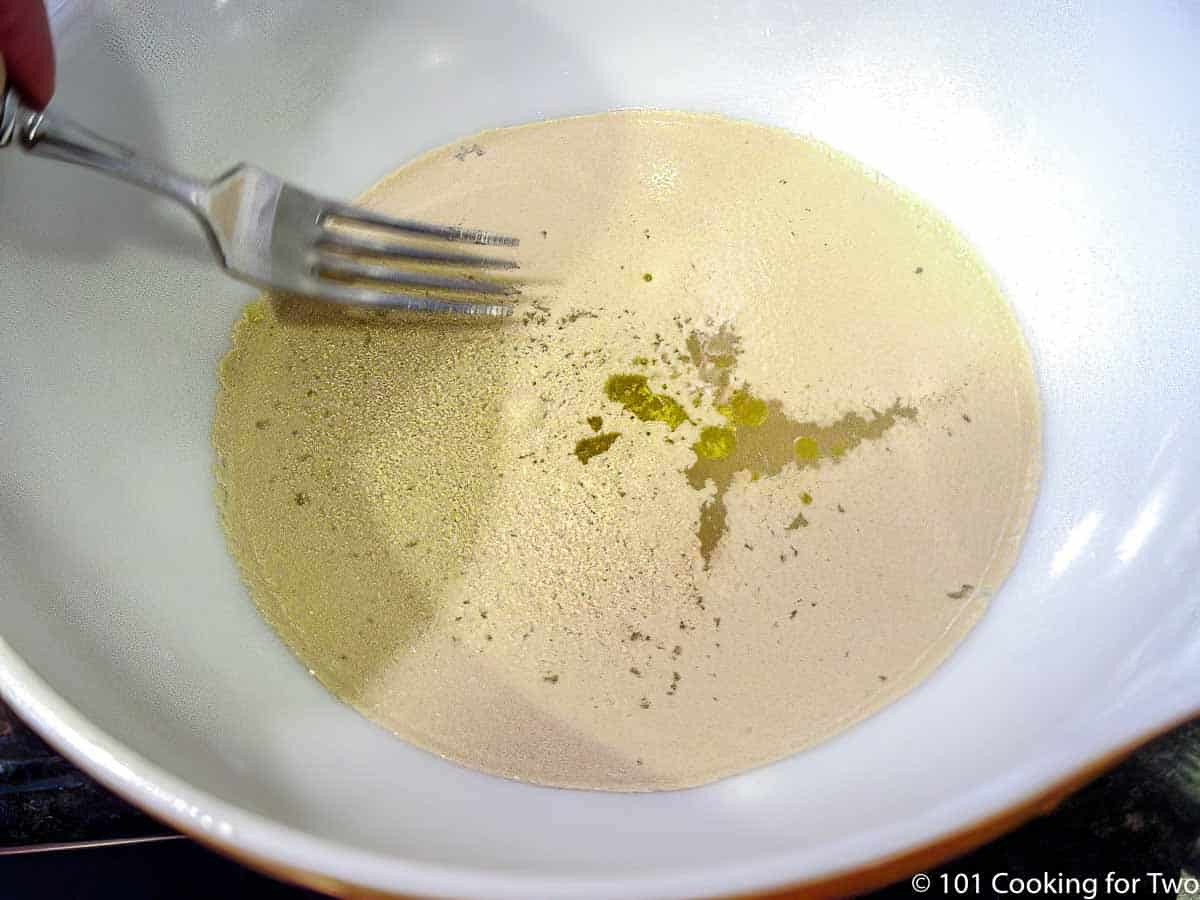
1. In a large mixing bowl, combine 2 cups of warm water (about 100°-110°) with 1 tablespoon of olive oil, 1 teaspoon of sugar, and one packet ( 2 ¼ teaspoons) of rapid/instant rising yeast. Mix well. Let sit a few minutes until foaming some, then add 1 teaspoon salt.
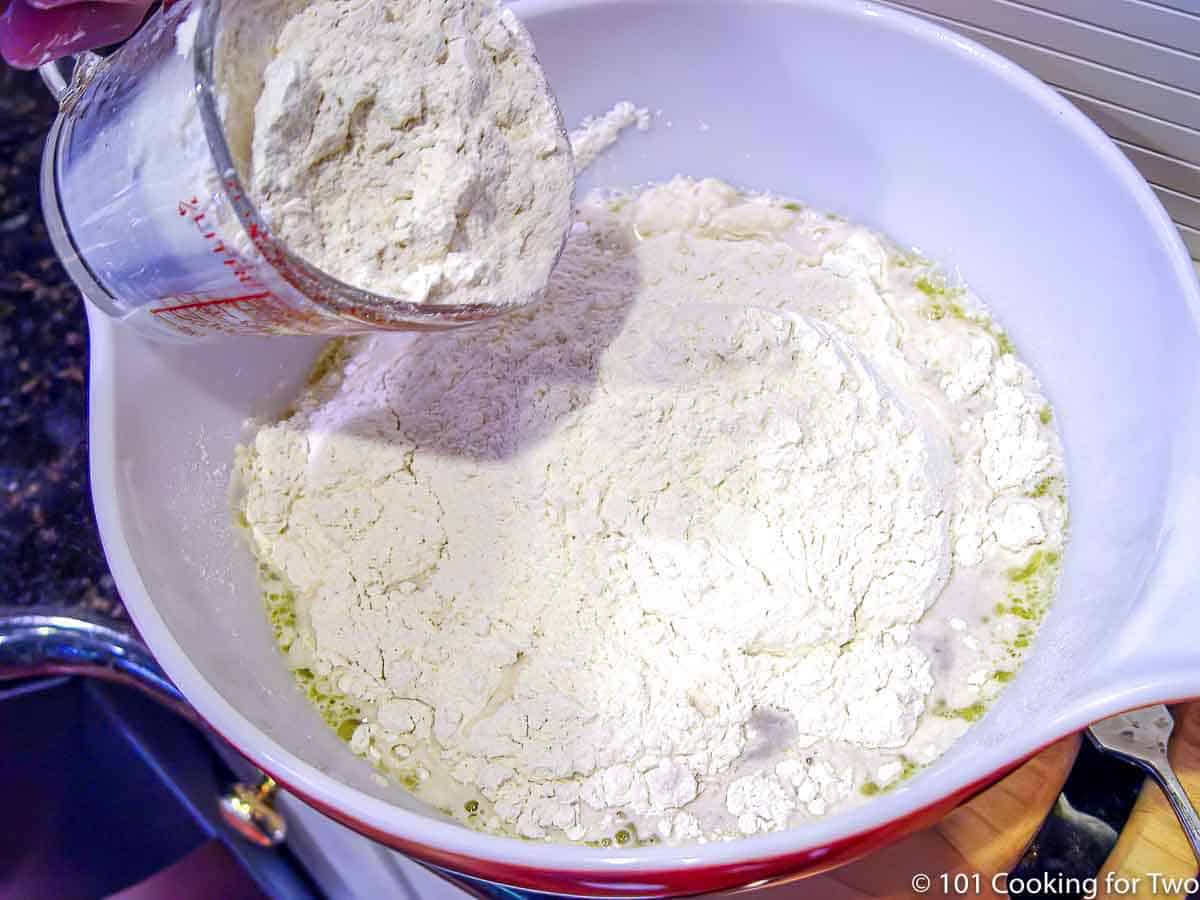
2. Add 4 cups of AP flour. Mix well with a spatula or wooden spoon. Finish with a bit of hand kneading to get all the flour incorporated for a few minutes in the bowl.
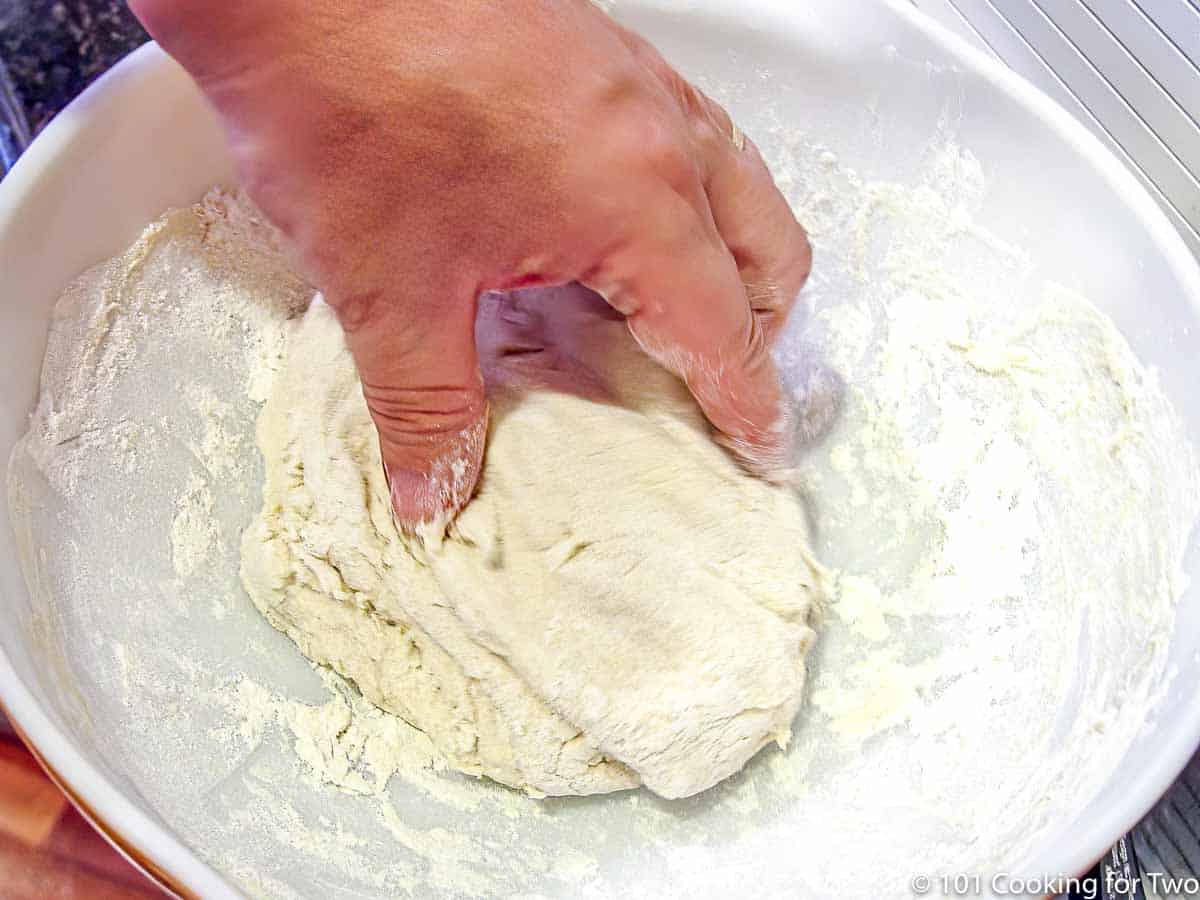
3. Add a little more flour or water to make it relatively light and still a little sticky or too firm. Usually, you won't need to add anything. Lightly coat the dough and the bowl with a bit of oil.
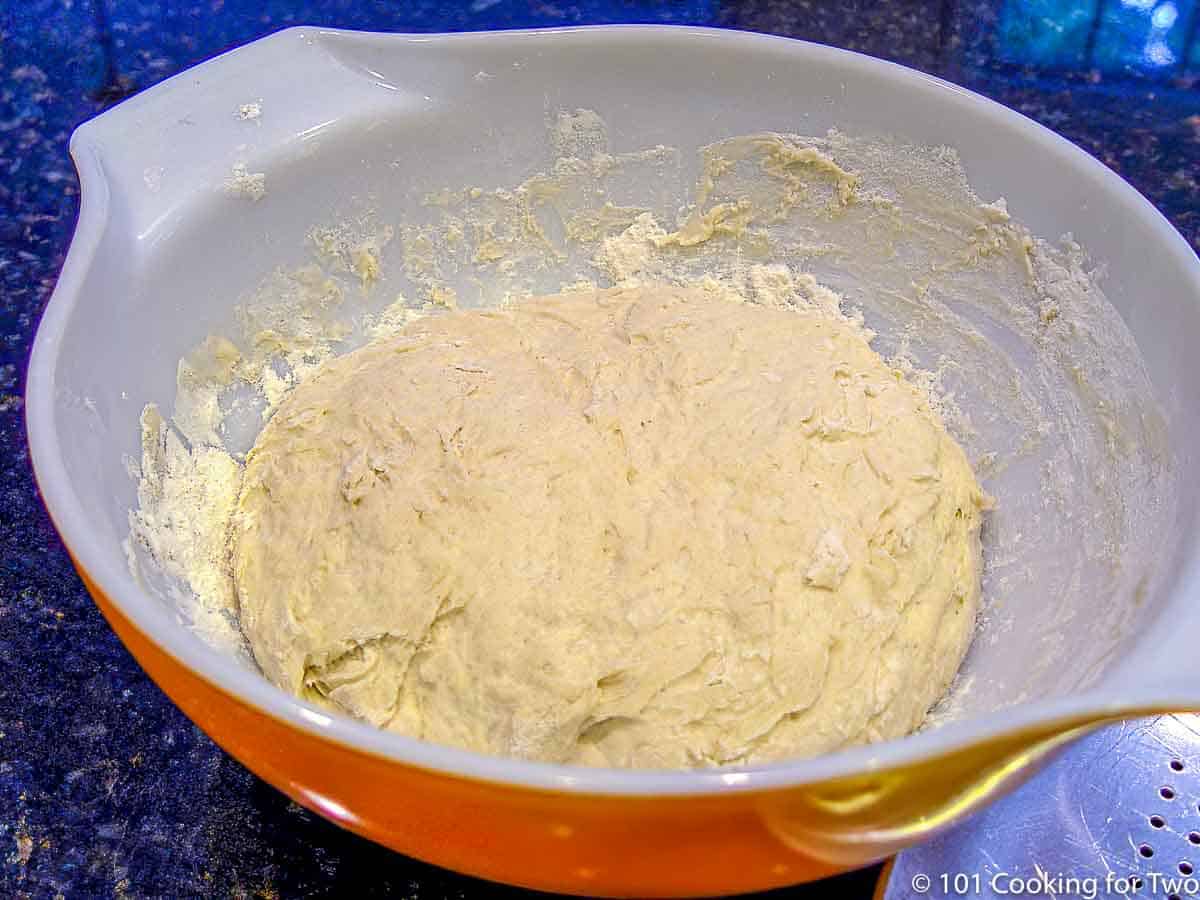
4. Cover with a towel or plastic wrap in a warm place until double in size — about 30 minutes.
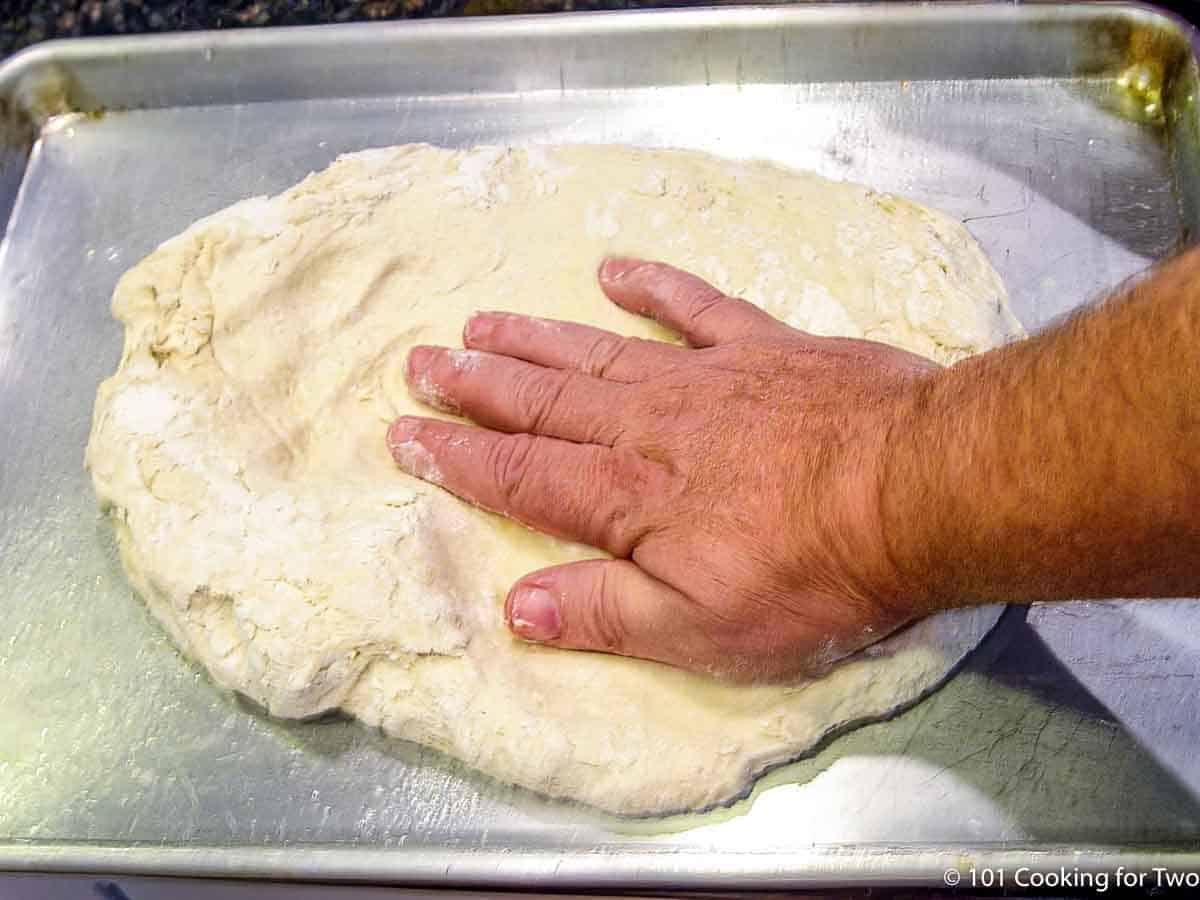
5. This recipe makes enough pizza dough for a 13X9 sheet pan or a 12-inch round pizza pan with a moderately thick crust.
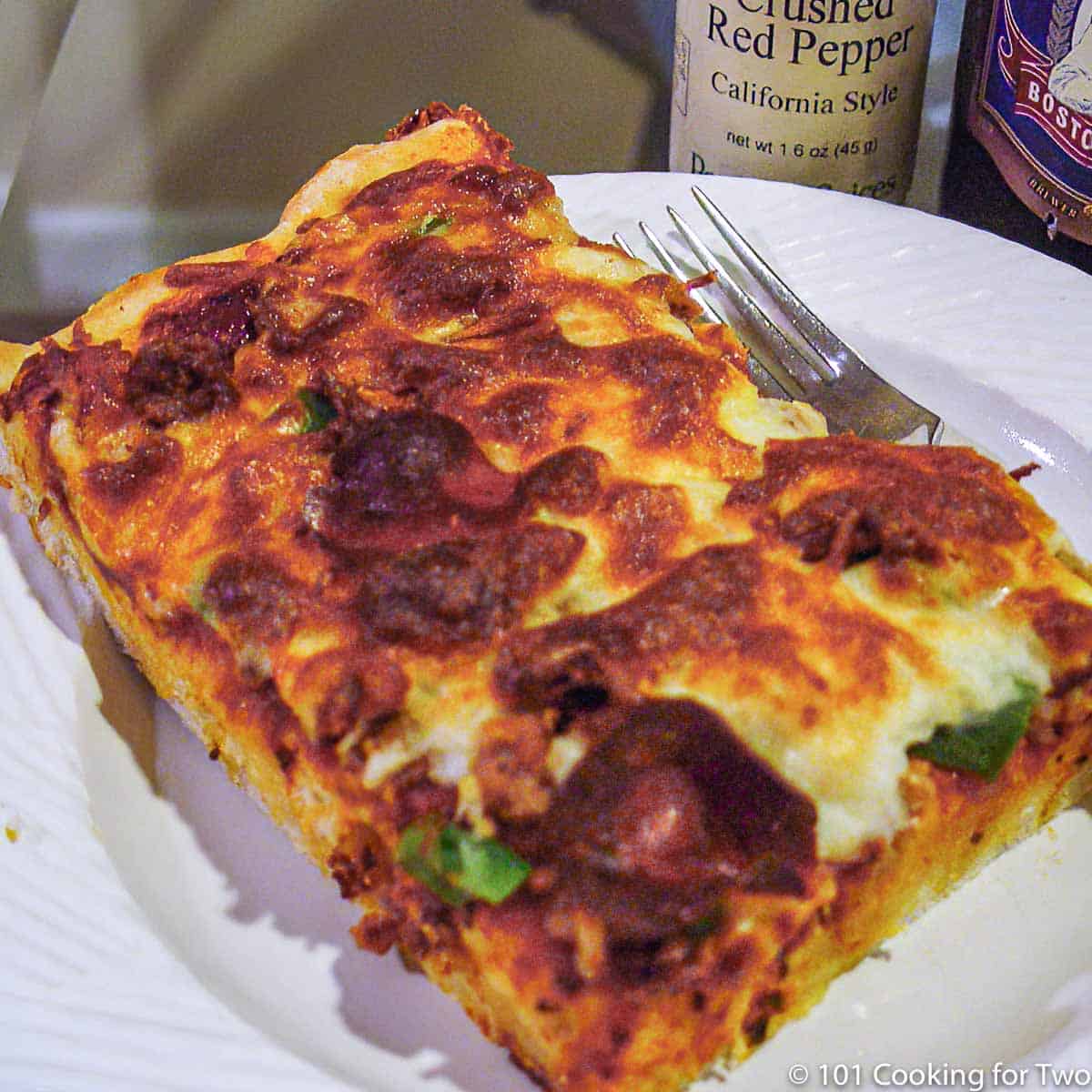
Keep reading for more details about ingredients and the next steps in making pizza. See the Recipe Card below for complete dough instructions and to print.
🥣Ingredient Notes
Flour:
Good old-fashioned all-purpose (AP) flour is my favorite for pizza dough because it gives a little rougher texture that enhances the pizza.
Bread flour works fine—the crust is a little crispier and finer in texture, but it is a good choice if you have it in the pantry. Or there is special pizza flour with a finer grind that will be very smooth.
I sometimes make partial whole wheat pizza using 25% whole wheat flour with honey instead of sugar, but more than 25% needs some special treatment. This is not a gluten-free recipe; gluten-free flour may work, but I'm not testing them.
Yeast:
All baking dry yeast is the same organism (Saccharomyces cerevisiae). Old-fashioned active dry yeast is processed differently and has less live yeast, so it will work slower. I suggest quick or instant yeast, which works faster.
Add the yeast to the water to be sure it is evenly distributed. And you should "proof" yeast by letting it sit for a few minutes to form some bubbles to "prove" that it is good.
The amount of yeast in a packet is about 2 ¼ teaspoons. I usually use bulk yeast and a light tablespoon (3 teaspoons minus a little) as the same thing.
Other ingredients for flavoring:
You can add extra flavor to the pizza dough with ¼ teaspoon garlic powder or other seasonings, like basil or oregano.
Keep it Warm!
You must "keep it warm." Here are a few tips.
- "Preheat" your bowl with hot water.
- Use water of 100°-110° in the dough.
- Do NOT put the bowl on a stone-type countertop. Put a wooden cutting board between it and the counter if that is where you want it to let it rise.
- Cover with a heavy towel or plastic wrap.
- Don't keep checking it. It will take about 30 minutes to double in size.
- If the house is cool, preheat your oven to its lowest setting, turn it off, and use it as your warm spot to raise the dough.
❄️Making Pizza Dough Ahead
Let the dough rise, then punch down and form a flattened ball. Give it a light coat of olive oil, then seal it tightly with plastic wrap. Good refrigerated for 1-2 days or frozen for 2-3 months. To thaw the frozen pizza dough, leave it overnight in the refrigerator.
Once thawed or just refrigerated, let the dough sit at room temperature for about 30-60 minutes, then make the dough out on the pan. Spreading cold dough is almost impossible. I like to let the dough start rising before making the pizza.
🍕Tips for Making Your Pizza
This recipe makes enough pizza dough for a 13X9 sheet pan or a 12-inch round pizza pan with a moderately thick crust. It will also make a thinner 16-inch round. You can also make two 9 to 10 inch round pizzas with medium crusts or two 12-inch pizzas with thinner crusts.
If using a pan, use a generous splash of olive oil and spread by hand. If using a pizza stone or grill, spread the dough with a rolling pin on a floured surface or pizza peel. You can use cornmeal instead of flour. If you don't have a pizza peel, use a baking sheet without a rim to transfer the pizza to the hot pizza stone.
You can also make mini pizzas, any size you want—watch the color when cooking.
Pizza Sauce
Please DO NOT use a jar or canned pizza sauce. Mine is much better.
My suggested sauce: One 6 oz can of tomato paste and 6 oz water. Add ½ teaspoon salt, ½ teaspoon pepper, 1 clove of garlic, about half a small chopped onion, and 1 teaspoon oregano—a pinch (¼ teaspoon) of crushed red pepper for a touch of heat.
The tomato paste gives a touch of sweetness and a deeper tomato taste than tomato sauce.
Toppings
Make a plain cheese pizza, a vegan veggie pizza, a pepperoni pizza, or any type you want.
I suggest about one pound of browned Italian sausage, a chopped ½ green pepper, and 4 oz of pepperoni, topped with 3-4 cups of mozzarella cheese. I like to toss a bit more pepperoni on the cheese before baking.
For a change of pace, try my White Pizza with chicken.
How to Bake Pizza in the Oven
Most of us don't have a high-temperature pizza oven, so use a preheated 400° convection oven or 425° conventional. Other oven temperatures may be used, but the cooking time will vary. If you cook a very thick pizza, a lower temperature is better. Very high temps for crispy, thin-crust pizzas.
The cooking time will vary by the thickness, amount, and types of toppings. It may be as low as 15 minutes, but my loaded pizza takes 20-25 minutes to brown nicely.
🎈Large Groups and Pizza Parties
This is an excellent recipe for a large-scale pizza party or group. The pizzas are large, and the dough is easy to make or make ahead.
So just multiply the ingredients as a starting point. I usually start with 2 cups of flour per cup of liquid.
One last thing to know: a pound of flour is about 3 ⅓ cups of flour.
❓FAQs
Yes. You can make out the dough on a pan, bake for 5 minutes, then let it cool and freeze. If you want, go ahead with the sauce, toppings, and cheese before freezing.
You can also freeze the dough after rising, punch it down, and form it into flattened balls after a light coat of oil and a tight wrap of plastic wrap.
Some recommend small fork puncture holes to prevent air bubbles under the crust. I don't bother with it. I have only seen a few bubbles over the years. If you elect to do this, do it like a pie crust.
The oven is, by far, the best way to reheat leftover pizza. And a pizza stone is preferred.
Put the leftovers on a cold pizza stone, give it a very light sprinkle of water on any crusty edge, then put it into a 350° oven without a cover.

This recipe is listed in these categories. See them for more similar recipes.
Have you tried this recipe, or have a question? Join the community discussion in the comments.
📖 Recipe
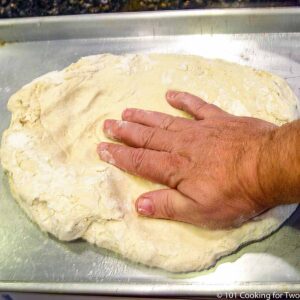
Easy Homemade Pizza Dough
Ingredients
- 2 cups water - 100°-105°
- 4 cups AP flour
- 1 pack rapid or quick yeast
- 1 teaspoon sugar
- 1 teaspoon salt
- 1 tablespoon Olive oil - olive oil preferred
- addition olive oil—for the dough, bowl, and pan.
Instructions
- In a large mixing bowl, combine 2 cups of warm water (about 100°-110°) with 1 tablespoon of olive oil, 1 teaspoon of sugar, and one packet ( 2 ¼ teaspoons) of rapid/instant rising yeast. Mix well. Let sit a few minutes until foaming some, then add 1 teaspoon salt.
- Add 4 cups of AP flour. Mix well with a spatula or wooden spoon. Finish with a bit of hand kneading to get all the flour incorporated for a few minutes in the bowl.
- Add a little more flour or water to make it relatively light and still a little sticky or too firm. Usually, you won't need to add anything. Lightly coat the dough and the bowl with a bit of oil.
- Cover with a towel or plastic wrap in a warm place until double in size — about 30 minutes.
- Use it to make your favorite homemade pizza. This recipe makes enough pizza dough for a 13X9 sheet pan or a 12-inch round pizza pan with a moderately thick crust.
Want to save this recipe for later?
Recipe Notes
Pro Tips:
- This recipe makes enough pizza dough for a 13X9 sheet pan or a 12-inch round pizza pan with a moderately thick crust. It is will also make a thinner 16-inch round. You can also make two 9-10 inch round pizzas with medium crust or two 12-inch pizzas with thin crusts.
- This is a great recipe to feed a large group or have a pizza party. Make the dough ahead or at the time it is needed. Start with 2 cups of flour per cup of liquid and add more as needed. And also know that 1 pound of flour is 3 ⅓ cups of flour.
- There is nothing really exact in this recipe. It will work as long as you are close. Just get the mixing texture right.
- Use AP flour. Bread flour can be used but will change the texture a bit.
- Non-wheat flours are probably not a good idea in this recipe.
- A package of yeast is 2 ¼ teaspoons. I use bulk yeast and generally use a "light" tablespoon.
- I like to "proof" my yeast.
- Use the sauce and toppings of your choice.
- I hate to say oven temperature doesn't matter, but I have cooked this with oven temperatures of 350° to 450° all with good results. I prefer higher temperatures a bit, but if you want that thicker crust, I don't like 450.
- You can make it ahead by letting it rise once, form into a flattened ball and give it a light coat of oil and seal it tight. Good refrigerated for 1-2 days or frozen for 2-3 months. To thaw the frozen dough, just overnight in the refrigerator. Once thawed or just refrigerated, let the dough sit at room temperature for about 30-60 minutes then make the dough out on the pan.
- Nutrition is calculated on the crust only.
Your Own Private Notes
To adjust the recipe size:
You may adjust the number of servings in this recipe card under servings. This does the math for the ingredients for you. BUT it does NOT adjust the text of the instructions. So you need to do that yourself.
Nutrition Estimate
© 101 Cooking for Two, LLC. All content and photographs are copyright protected by us or our vendors. While we appreciate your sharing our recipes, please realize copying, pasting, or duplicating full recipes to any social media, website, or electronic/printed media is strictly prohibited and a violation of our copyrights.
Editor's Note: Originally published September 14, 2011, but used since the mid-1960s, updated with expanded discussion, new photos, and a table of contents.


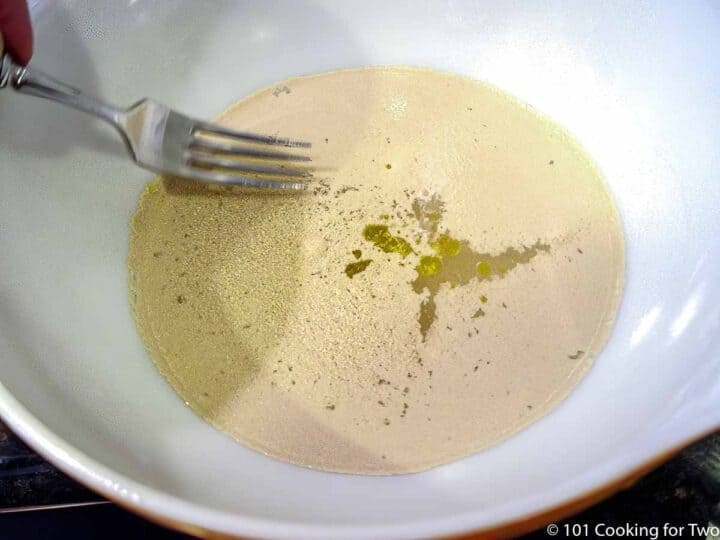
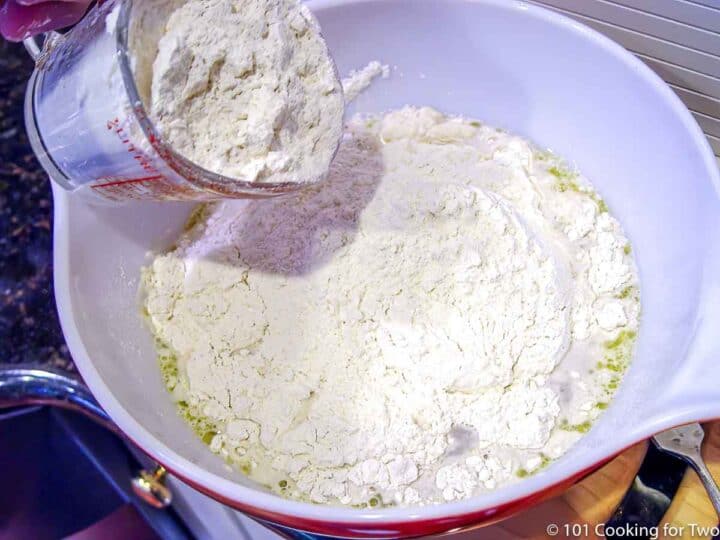
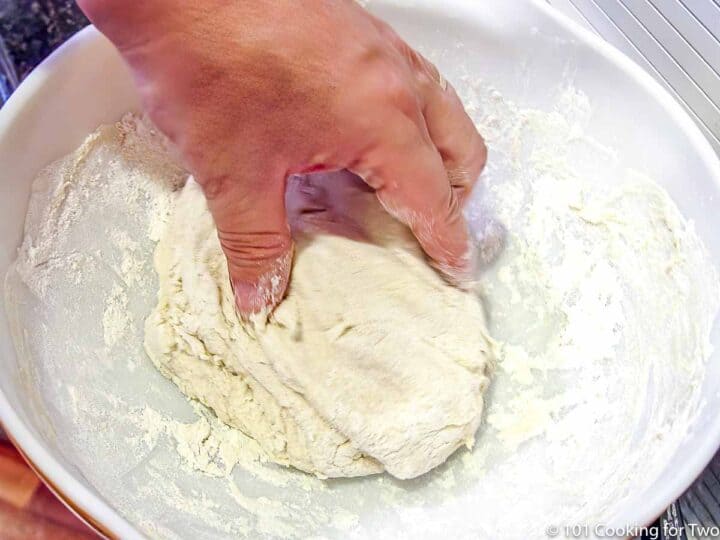
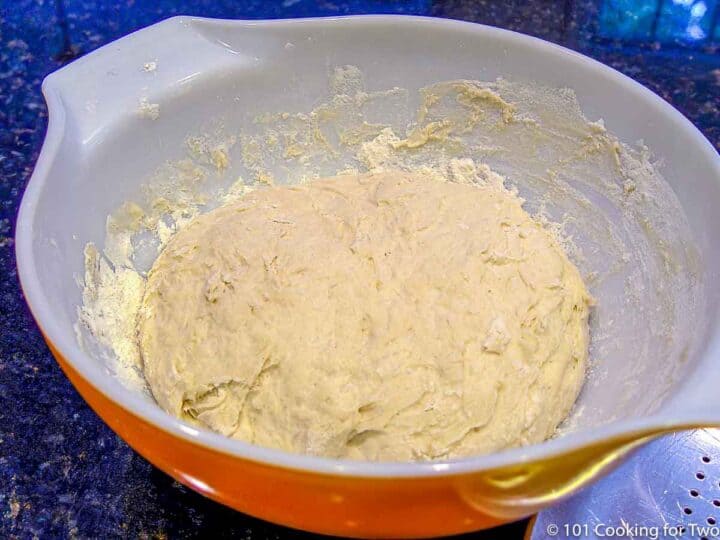
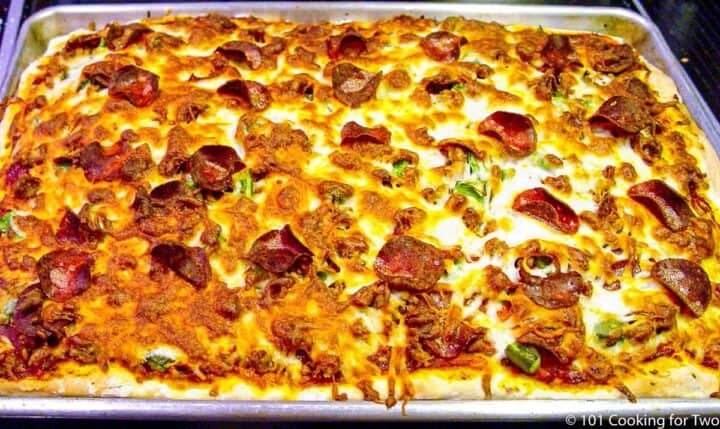
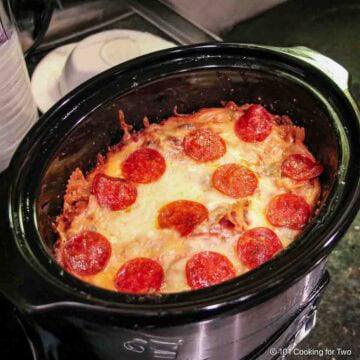


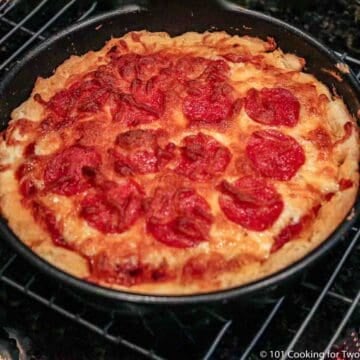
Jo Ann Thomas says
Tks so much for sharing your recipes. I use to cook and bake for a large family. Now I cook just for myself mostly. So glad I found your web site for smaller recipes. I look forward to using your recipes. Thank you again.
Dave Laughlin says
I wish you had given a weight, grams or ounces, to your flour. Everyone has a different way of measuring a cup of flour.
Kris Hodges says
Made yesterday, divided in half for 12" pizza, froze the other ball for later. Nice and crisp when cooked and held up to way too many toppings that my husband chopped for me. We really enjoyed. Best pizza I've ever made! Thanks so much.
Dan Mikesell AKA DrDan says
Hi Kris,
Welcome the blog.
Glad it worked well for you. I think you will enjoy this one for years like I have.
Thanks for the note and rating.
Dan
Mary-Lou says
Hello Dan,
I am new to this website. I find your recipes to be most interesting and non-convoluted (I am sure you know what I mean.). I am going to try this recipe: "Easy Everyday Pizza Dough". You did not include the required temperature for conventional. When you do not specify, (as in this case), should I just add 25 degrees to the stated convection temperature to derive the conventional temperature?
Thank you.
~Mary-Lou
Dan Mikesell AKA DrDan says
Hi Mary Lou,
Welcome to the blog.
This is a recipe I started using in the 1960's You can cook this anywhere from 350-450 degrees. I like to keep it in the 400 to 425 range. Would I do 450 conventional? Probable if the dough spread out thin. If I was doing thicker crust, I would keep the temp down a bit. A higher temp will usually give a crispier crust but if it is a thicker dough, the center can be a bit spongy.
You are correct that usually just adding 25 degrees for conventional oven is a good general rule but when I get above 400 degrees, I tend not to do it and just add a bit of time.
Dan
DrDan says
Yep,
Any flour will do other than whole wheat. There are other recipes for whole wheat but I rarely do them... The texture is wrong to me.
With this recipe (which I'm sure I have done hundreds of times for almost 40 yrs) AP flour gives a "rougher" more homemade/rustic texture that I prefer for homemade pizza. I really like that.
The bread flour gives more gluten and finer texture. A little more pizza parlor like.
I have never used 00 but it should be fine.
I do this occasionally on a stone. I have a large wooden pizza peel that I make the pizza on then slide it onto the hot stone. If you don't have a peel then use a cookie sheet without sides and slide it off that.
Dan
Leslie says
Would like to make for grandkids. Have you ever used bread flour, 00 flour or cooked on a pizza stone?
Chris says
Have you ever tried 00 flour for your pizza dough?